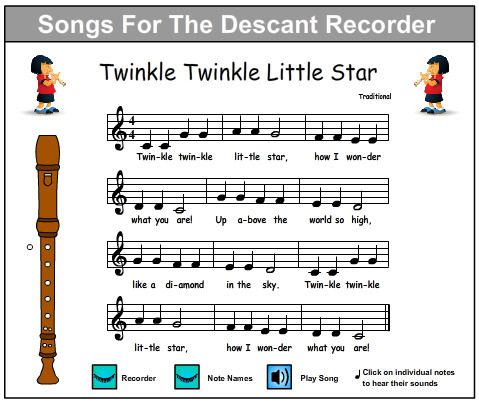

The melody is first played at a quick speed (up to 0:46), then again very slowly for practice purposes. Slow practice is very important when learning a new piece.

Twinkle twinkle little star recorder pdf#
This is very important.ĭownload the PDF Twinkle Twinkle Little Star.pdf and ask your child to practice the melody, a piece at a time, slowly. Make sure they are playing these notes with their left hand at the top of the recorder and their right hand at the bottom. Your child can put the mouthpiece of the recorder under their arm for a few minutes.ĭownload the PowerPoint titled Notes B, A, G, F sharp, E and D.pptx Tell your child to practice these musical notes on the recorder. The recapitulation repeats the music of the exposition.Important: before starting this lesson, make sure your child’s recorder is clean. The exposition presents the melodic material of a composition and the development, as you might guess from its name, develops those ideas. There are three main sections in sonata form - the exposition, development, and recapitulation. This form was created and refined during the classical era (1750-1820).

Sonata form is a particular structure of a piece of music. Sonata is the name given to pieces of music that feature a solo instrument or a solo instrument with piano. It is also possible to have a form of ABACADA, with each letter representing a different musical idea. There are several structural possibilities in rondo form. The A section always comes back after the contrasting sections and it concludes the piece. Rondo form has a main section (A) that is alternated with contrasting ideas. Please do not mock Twinkle, Twinkle, though - it was good enough for Mozart to write a theme and variations based on it’s melody. The sections in classical forms are usually much longer than this simple song. The A section is “Twinkle, twinkle, little star, how I wonder what you are.” The B section is “Up above the world so high, like a diamond in the sky.” And the last A section repeats the beginning. A simple example of ABA form occurs in Twinkle, Twinkle, Little Star. The A section then comes back to conclude the piece.

Many songs have a form of ABA, which means the first section - A - is followed by a contrasting section - B. Rhapsody on a Theme of Paganini, by Sergei Rachmaninoff (1873-1943), has twenty-four variations.Ĭapital letters are used to represent sections in some forms. There is no limit to the number of variations in this form. Sometimes the theme will be presented in a major key and a variation will be played in a minor key. For example, one variation may feature the violins, while the oboe plays the next variation. Each of the sections can alter the melody, harmony, rhythm, or orchestration. Theme and variations, like the name suggests, has a main theme that is followed by sections that have some variation on it. The main forms in classical music are theme and variations, rondo, and sonata form. Most symphonies have four separate movements that usually can stand on their own as independent works. A movement is a large section within an even larger piece of music. Many compositions, like symphonies, sonatas, and concertos, are broken down into movements. Even when the words change, the music stays the same. Strophic form consists of one melody that is written for several stanzas of poetry. It is found in most popular music, folk music, hymns, and Christmas songs. Strophic form is the simplest example of form in music. Form is simply the structure of a piece of music. Recognizing the repetition, variation, and contrast in a piece of music helps us understand its form. It adds interest to music because pieces that consist of one repeated idea can be very boring. Contrast is a complete change from anything else that has been played in the music. Those alterations may occur with slight changes in rhythm, melody, or harmony. Variation is a repeat of an idea with some alteration. A melody is often repeated so that it stays in the memory and makes better sense in our minds. Repetition is important because it helps hold the music together. From that point onward everything is either a repetition of that idea, a variation of it, or a complete contrast to it. Have you repeated the same things that you did yesterday or some other day? Have you done the same things as yesterday but in a slightly different manner? Have you accomplished something completely different that you have never done before? When you think about it, everything in life is a repetition, variation, or contrast.Īt the beginning of a musical composition an idea is presented. Take a moment and think about what you have done today.


 0 kommentar(er)
0 kommentar(er)
